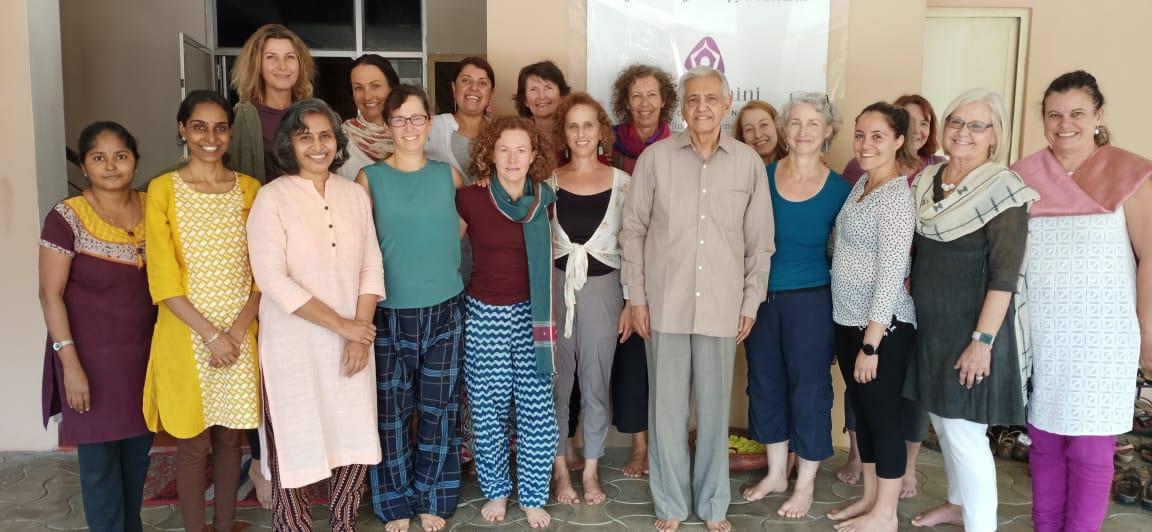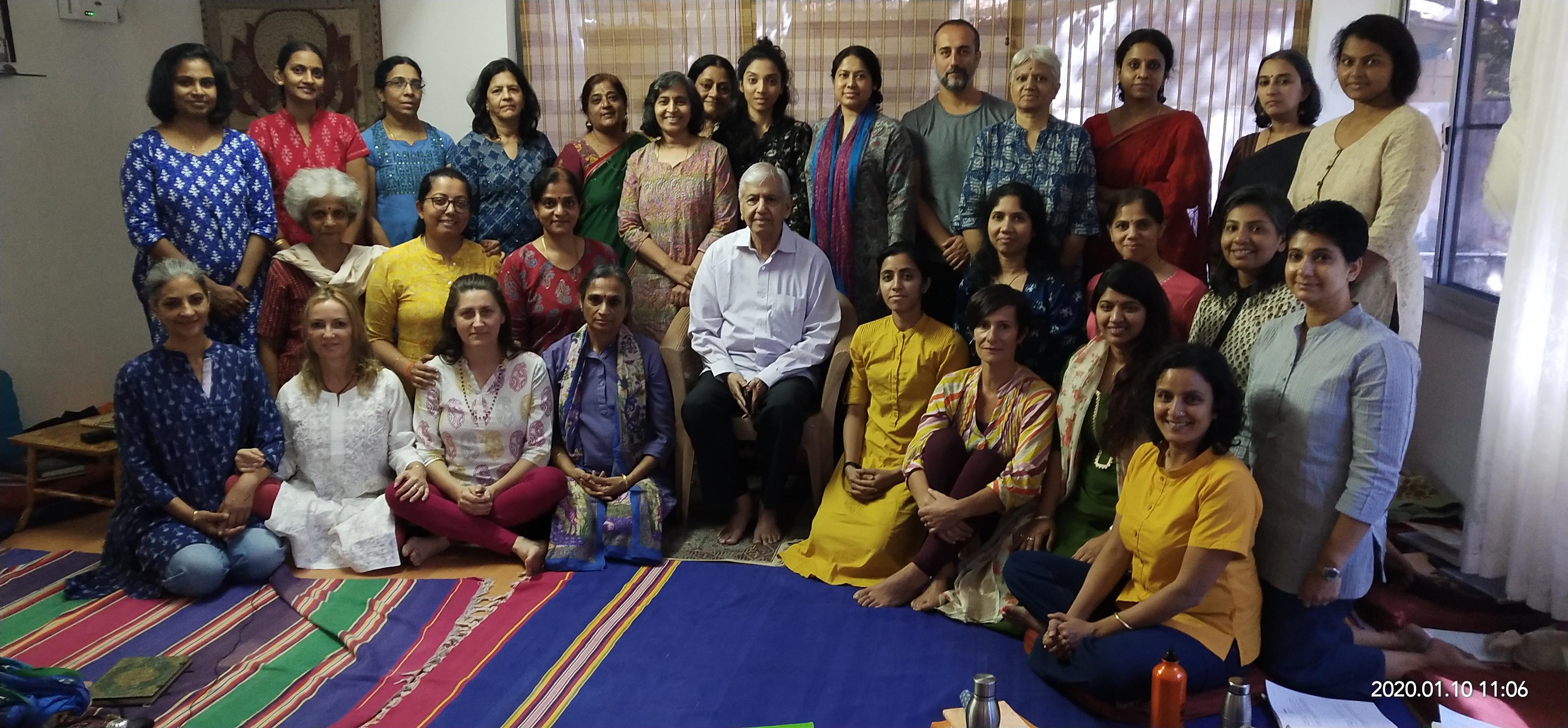February 2020 Newsletter from Srivatsa Ramaswami--Siksha(study/chanting)
82 views
Skip to first unread message
Srivatsa Ramaswami
Jan 31, 2020, 8:52:42 AM1/31/20
to Vinyasa Krama Yoga Announcements
February 2020 Newsletter from Srivatsa Ramaswami--Siksha (study/chanting)
In January 2020 I taught a 20 hr program on Yoga Yagnyavalkya, going through the entire text word by
word verse by verse. It was at Yoga Vahini in Chennai. I also spoke briefly about the factors to be considered for developing a personal practice.

I will be teaching a 100 hr Vinyasakrama Teacher Training program for Yoga Vahini. The course for 15 days will include 60 hrs of asanas and vinyasas, 20 hrs of pranayama, dharana and yoga for Internal organs and a 20 hr segment on Yoga Sutras, It starts on February 5th.
My son Badri Ramaswami Srivatsa (BRS Bankphee) has published a cute little book for children titled "Look Before You Leap, Rabbit" through Amazon. Both print and kindle versions are available. Please share with friends if you like it Here is the link
Siksha
Muktikopanishd lists 108 upanishads. According to scholars if one can understand one upanishad, the terse short Mandukya upanishad, then reading the other upanishads may not be necessary; if not the other upanishads are helpful. There are ten upanishad that are considered essential reading for vedanta students, including Mandukya. One of them is Taittiriya upanishad which is still chanted and studied even today. It has three chapters. The second and third chapters explain the nature of Brahman the ultimate reality. Many yoga practitioners are familiar with the five kosa model of the Self. But the first chapter, called siksha valli or the chapter on learning , learning the vedas. Siiksha is generally interpreted in this context as phonetics etc, but it basically defines the parameters for the study and chanting of the vedas. The six parameters are 1. varna or the characters or letters. The pronunciation of each character is precise unlike in some other languages like English where the same character like 'c' can have different pronunciation in different words. The student must chant every varna or letter correctly. Then 2. is swara or note. In tittiriya saka and upanishad there are 3 notes. In the entire veda the notes are fixed and can not be altered. So the chanter who in the olden days had to memorize the vedas has to memorize the notes as well, so much so when a group chants it will be in unison. The third parameter is matra is the pitch of each syllable and that is also defined. That is vedic mantras are not supposed to be sung in which the matra rule may be broken. The fourth one is bala or strength of the voice. Usually vedic chanting is full throated. Then we have saama which is modulation, the chanting should not jerky and finally santana or conjunction. Sanskrit follows conjunction rules and the chanter should chant without breaking the conjoined words. While learning, the teacher may break them to individual words but while doing the chant the conjunction rules should be strictly followed. These are the rules prescribed by this upanishad for chanting the vedas especially the krishn yajur veda of which Taittiriyaupanishad is a part.
All over the world many students apply for admission to better known schools. Many top schools also would like to admit top students and they vie with one another, to admit high achievers, outstanding sportsmen and sportswomen. In the olden days many would like to study with outstanding vedic teachers/rishis. And the teachers also would like to have students, highly able. They would get students through word of mouth. Thy also would perform a religious rite using the mantra. "May vedic students come to me from all quarters. May students with varied capabilities come to study with me. May students with proper preparations come to me. May youngsters with good self control come to me. May students come to me with a calm disposition. OM". They believed in the efficacy of the mantras and prayers.
Brahman is the real source of the universe and also individual self is driven home even at the stage of student.The student is encouraged to identify with the brahman/atman right from the young age. Here is mantra said to have been enunciated by a sage called Trisanku. " Like the root of the tree, I (Brahman) is the source of this entire universe. But the Self/Brahman is supreme and pure. It is the highest. Real happiness is only in the Self and not in possessions. Only a pure mind can recognize the Self, It illuminates by itself, beyond death, unaffected by any ailments or any change whatsoever. This is the mantra of sage Trisanku"
Vedas are known as shrutis as they are 'heard' and not read say from a book. For a long time vedas were only recited and heard but were never written for whatever reason. But the vedas were preserved for thousands of years. How was it possible? A few vedic scholars when young would learn the vedas from the teacher teaching orally and the pupil would be listening and repeating the passages over and over again along with the svaras or notes they would commit to memory. This process is called adhyayana. But since there are no written text these veda repositories will become teachers and transmit the vedas to the next generation. For them to keep the vedas in memory they have to chant them everyday lest they forget. So learning, chanting called swadhyaya and teaching called pravachana were the activities to be done to preserve the vedas. If you take the taittiriya sakha of yajur veda of which one of the prapatakas is the sikshaa valli and which is the source for this article, there are 81 chapters or prapatakas. And to just chant the entire taittiriya branch it would take about 40 hours. And to remember them all without missing a syllable or a note requires repeated study daily chanting and teaching to the next generation of students. So the teacher at the end of the study by the students would exhort them to chant the vedas regularly and teach it as well, Further to maintain good memory they would have to maintain some good discipline. Here is the mantra starting with "rtam cha svadhyaya pravachane ca"
Be straightforward, chant and teach (the vedas)
Speak the truth, chant and teach
Live austerely, chant and teach
Maintain sense control, chant and teach
Maintain control of the mind, chant and teach
Do the ordained fire duties, chant and teach
Do daily fire duties, chant and teach
Respect unannounced guests,chant and teach
Be humane, chant and study
Have children, chant and teach
Continue family life, chant and teach
Have grandchildren, chant and teach
This may also be relevant to yoga teachers. Maintain discipline, study well, practice well so that you can teach well.
The pranava or Om is the most important vedic mantra.The chapter emphasizes the importance of the mantra in a long passage Translated here under
The mantra "OM" is Brahma. And all these are in OM . The priests say "OM" to gods and goddesses. When the priests start chanting Sama hymns they start with "OM". When they recite the sastras they say "OM" at the beginning. The adhvaryu priest while performing the fire sacrifice (Yagnya) keeps repeating "OM" before any action. The presiding priest Brahma says "OM" to give assent. Those householders who do the agnihotra fire ritual start with "OM" Many scholars study the vedas to realize Brahman the ultimate and immediate reality, before they start, say "OM" so that they can realize the Brahman
And finally the chapter ends with the address of the teacher at samavartana or conclusion of the study akin to convocation/commencement address. Sri Krishnamacharya while teaching chanting of this chapter looked up one day and said that since I had studied English I could translate this portion have it printed and distribute to as many people as possible. I just did that , gave a few copies to my teacher and a few to my friends. It contains a number of commands or adesa. The rishi says that this is not just commands but also commends (upadesa). indicating these commands are for the good of the departing student for all life. Four of them are outstanding and are often quoted in India
Mother is divine
Father is divine
Teacher is divine
Guest (unannounced/stranger) is divine
Reply all
Reply to author
Forward
0 new messages

